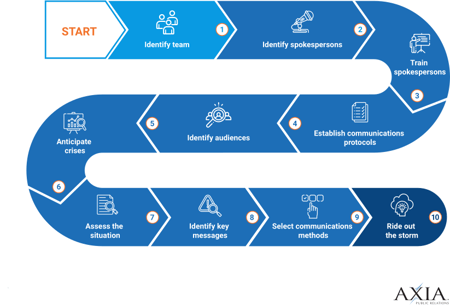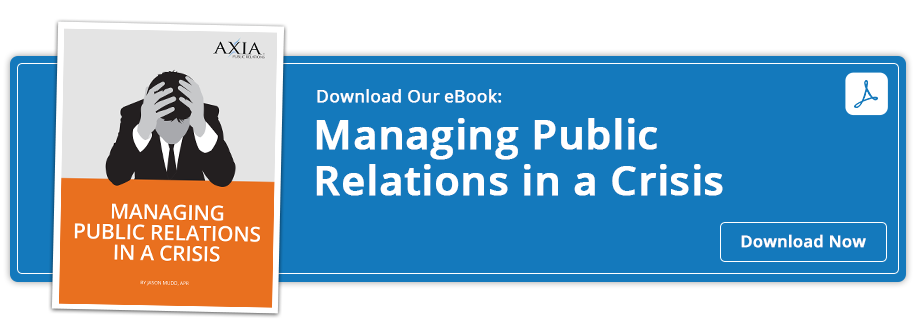 By Jonathan Bernstein and Jason Mudd, APR
By Jonathan Bernstein and Jason Mudd, APR
Current events demonstrate that a crisis can strike a company at any time. It's a matter of when, not if. Don’t think that it can’t happen to you.
Natural and man-made disasters happen all the time and often without notice. No one knows when or if events like the Sept. 11 terrorist attacks, SARS, anthrax, or a tornado may occur. In these times, every business must be prepared. Otherwise, you risk the possibility that the media will drag your company through the wringer and allow the public to judge you by scandalous front-page headlines.
Even if it’s not a scandal, it could result in a devastating event that stops operations for an extended period. No one hopes for or expects such tragedies, but you never know. Preparation is essential. The following steps are great tips for forming a crisis communications plan for your business.
Use these 10 steps to gain the advantage and proactively prepare for the worst.
1. Identify and activate your crisis communications team
Ideally, the company CEO leads a small group of senior executives with the top public relations executive and legal counsel as chief advisers.
2. Identify spokespersons.
These individuals are the only company officials authorized to speak for the company.
3. Provide spokesperson training.
Some executives are brilliant at business and not very effective communicators. Well-intentioned executives believe they don’t need professional training in speaking to the media. Beware. Not knowing how to get “the most important news” across to the interviewer, how to answer difficult questions, or how to handle a heated exchange, can devastate your company and your career, especially during a crisis.
4. Establish communications protocols.
Establish an emergency communications “tree” and distribute it to all company employees, informing them what to do and who to call if there’s an actual or potential crisis.
5. Identify and know your audiences – internal and external.
Remember your employees, the community, media, customers, private investors, SEC requirements, and regulatory agencies.
6. Anticipate crises.
Be proactive and brainstorm potential crises. Modifying existing methods of operation can often prevent crises. Plan layoffs, acquisitions, and other news to avoid operating in crisis mode.
7. Assess the situation.
Reacting without adequate information is a classic “shoot first and ask questions later” scenario. With proper planning, you can follow your crisis plan.
8. Identify key messages.
Keep it simple with no more than three main messages for all audiences and a few messages explicitly targeted at key audiences.
9. Select communications methods.
Brief your key audience. This might include shareholders, regulators, employees, (previous, current, and future) customers and clients, investors, industry, and the communities they serve. Depending on the relationship and number of contacts, you might communicate this personally either in-person or by audio or video calls or recordings, via text messages, e-mails, and social media posts. You might distribute media statements, news releases, or hold in-person or videoconference briefings also known as news conferences for the media.
10. Ride out the storm.
Some audiences simply won't react the way the organization wants. I advise clients to take an objective look at how the market is reacting. From that, determine if making additional communication is worth the effort. Sometimes, it's not, and you need to ride out the storm.
By following these steps, you can create a plan that you can use at any time during a crisis. Provide copies to all department heads and managers. Keep copies of this plan available as a hard copy and on the computer network. Once you've developed your plan, keep it handy for review and schedule practice drills. Leading your team through a mock crisis helps you prepare for the real thing; everyone should get together to evaluate the plan after each mock crisis. The crisis team should meet twice a year to review and update the plan.
 Jason Mudd is a trusted adviser and dynamic strategist to some of America’s most admired and fastest-growing companies. He is the chief executive and managing partner of Axia Public Relations, one of America’s Best PR Agencies according to Forbes magazine. He is a professional public speaker, accredited public relations practitioner, author, podcaster, and entrepreneur. Connect with Jason on Twitter @jasonmudd9 and Axia Public Relations @axiapr. Be sure to tweet and share your thoughts below. We’ll read and respond to each of them.
Jason Mudd is a trusted adviser and dynamic strategist to some of America’s most admired and fastest-growing companies. He is the chief executive and managing partner of Axia Public Relations, one of America’s Best PR Agencies according to Forbes magazine. He is a professional public speaker, accredited public relations practitioner, author, podcaster, and entrepreneur. Connect with Jason on Twitter @jasonmudd9 and Axia Public Relations @axiapr. Be sure to tweet and share your thoughts below. We’ll read and respond to each of them.
Featured image credit: 123rf.com
Topics: public relations, crisis communications



Comment on This Article